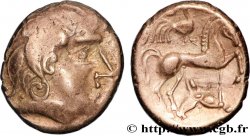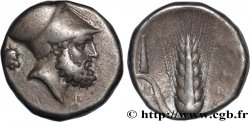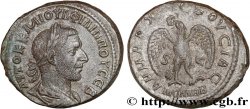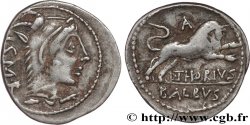bga_1011147 - GALLIA - LEMOVICES (Area of Limoges) Statère à la grue
2 500.00 €(Approx. 2875.00$ | 2200.00£)
Quantity
Add to your cart

Type : Statère à la grue
Date: c. 100-50 BC.
Mint name / Town : Limoges (87)
Metal : electrum
Diameter : 17,5 mm
Orientation dies : 12 h.
Weight : 6,66 g.
Rarity : R2
Coments on the condition:
Très beau statère sur flan un peu court et centré, une légère faiblesse à trois heures au droit. Joli revers bien complet. Patine de collection
Catalogue references :
Obverse
Obverse legend : ANÉPIGRAPHE.
Obverse description : Tête à droite, la chevelure en grosses mèches aquitaniques.
Reverse
Reverse legend : ANÉPIGRAPHE.
Reverse description : Cheval à droite, une grue posée sur la croupe et un trèfle entre les jambes.
Commentary
Cette variété correspond à la classe II de la série 1076 “à la grue et au trèfle” du Nouvel Atlas.
Le motif d‘accolade partant de la bouche, devant le visage, est parfois interprété comme le signe de la parole ; on retrouve ce détail sur les statères des Bituriges, mais aussi sous forme des deux dauphins, plus ou moins stylisés, sur la plupart des monnaies d’argent du sud, dites “à la croix”. On notera qu’au revers, le cheval a lui aussi une sorte de volute qui lui sort de la bouche.
This variety corresponds to class II of series 1076 “with the crane and the clover” of the New Atlas. The hug pattern starting from the mouth, in front of the face, is sometimes interpreted as the sign of speech; we find this detail on the staters of the Bituriges, but also in the form of the two dolphins, more or less stylized, on most of the silver coins of the south, known as “the cross”. Note that on the reverse, the horse also has a sort of volute coming out of its mouth.
Le motif d‘accolade partant de la bouche, devant le visage, est parfois interprété comme le signe de la parole ; on retrouve ce détail sur les statères des Bituriges, mais aussi sous forme des deux dauphins, plus ou moins stylisés, sur la plupart des monnaies d’argent du sud, dites “à la croix”. On notera qu’au revers, le cheval a lui aussi une sorte de volute qui lui sort de la bouche.
This variety corresponds to class II of series 1076 “with the crane and the clover” of the New Atlas. The hug pattern starting from the mouth, in front of the face, is sometimes interpreted as the sign of speech; we find this detail on the staters of the Bituriges, but also in the form of the two dolphins, more or less stylized, on most of the silver coins of the south, known as “the cross”. Note that on the reverse, the horse also has a sort of volute coming out of its mouth.








 Report a mistake
Report a mistake Print the page
Print the page Share my selection
Share my selection Ask a question
Ask a question Consign / sell
Consign / sell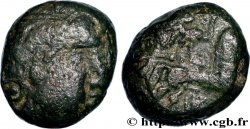
 Full data
Full data



